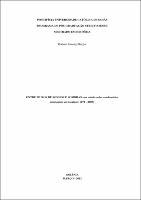| Compartilhamento |


|
Use este identificador para citar ou linkar para este item:
http://tede2.pucgoias.edu.br:8080/handle/tede/2245| Tipo do documento: | Dissertação |
| Título: | ENTRE MUROS DE SONHOS E SOMBRAS: um estudo sobre condomínios horizontais em Goiânia (1978 - 2005). |
| Título(s) alternativo(s): | Among the walls of dreams and shadows: an essay about horizontal residential condominiums in Goiânia (1978 2005). |
| Autor: | Borges, Darlene Limongi  |
| Primeiro orientador: | Reinato, Eduardo José |
| Primeiro membro da banca: | Ferreira Neto, Maria Cristina Nunes |
| Segundo membro da banca: | Nunes, Heliane Prudente |
| Resumo: | Este estudo traz como proposta inicial o exercício de dialogar com diferentes estudiosos a tessitura da urbe. Tendo como base uma pesquisa bibliográfica, no alinhavar das leituras propostas, o trabalho considera a visão dos seguintes autores: Henri Lefebvre, pontuando que a construção da sociedade urbana ocorre enquanto há sua procura; Le Goff, com abordagem sobre as cidades medievais; Sandra Pesavento, na percepção de que a cidade é uma realidade objetiva, detentora de história e memória; Milton Santos, com o olhar sobre o espaço urbano e Lewis Mumford, tracejando a história das cidades; dentre outras referências que fazem parte da reflexão. Conhecer a cidade torna-se indispensável para a compreensão das sobreposições de formas e funções que o espaço urbano adquire, assim como o papel do urbano nesse processo. Para discutir o mote principal do estudo condomínios horizontais fechados foi feito inicialmente um recorte temporal, envolvendo as cidades medievais e industriais, oportunidade para identificar o papel das muralhas nos enclaves medievais, bem como a origem dos subúrbios. A leitura dada às cidades industriais objetivou a compreensão da dinâmica socioeconômica, que representou a proliferação dos subúrbios. As duas imagens muralha e subúrbio são referenciais para o olhar projetado sobre os condomínios horizontais. Entre a leitura dada à urbe e aos condomínios horizontais, o estudo propõe um breve histórico da cidade de Goiânia, visto que identificar o processo de formação e crescimento de uma cidade favorece a concepção de novas formas e funções que a urbe adquire, assim como, amplia a percepção de que a presença dos condomínios horizontais está induzindo a uma nova leitura sobre a periferia urbana. No entanto, longe de esgotar a temática, este estudo é um convite ao questionamento sobre iniciativas que o urbano toma para contemplar seu imaginário, sua opção de moradia e convivência. Portanto, antes de tudo, os esforços estão em acrescentar um novo olhar ao discurso, representações, sonhos e sombras que orlam Goiânia em uma nova roupagem. |
| Abstract: | The prime proposal of this essay is to exercise an exchange of different scholars ideas about the structure of urban areas. A bibliographical research becomes the basic compilation of selected surveys: Henri Lefebvre who points out that the social construction occurs whenever there is a demand; Le Goff and his analysis about medieval cities; Sandra Pesavento in her perception that a city is an objective reality, holder of history and memory; Milton Santos and his view on the urban space; Lewis Mumford tracing the history of cities; among many other references that are compiled in this assessment. Thus, discerning a city becomes essential for understanding overlaps of the forms and functions which the urban spaces attain, as well as the role of the city in this process. In order to discuss the main subject of this essay closed horizontal residential condominiums an initial time report was conceived involving medieval and industrial cities. Also, the opportunity to identify the role of city walls surrounding medieval towns, as well as the origin of the modern outskirts. These two images wall and suburb are references for a deeper glimpse about horizontal residential condominiums. In relation to the point of view given to urban areas and the condominiums, there is a proposal of a brief history of the city of Goiânia. Thus, the recognition of a city growth process leads to the notion of new forms and functions the city attains. Therefore, it is necessary to notice that the appearance of these horizontal condominiums is causing a new perspective about the outskirts of the modern cities. Without any intention of overtiring this theme, this paper becomes an invitation for questioning about initiatives that are taken in the cities, as well as envisaging new ideas, new aboding options and familiarity. So, first and foremost, the attempts are presented for the addition of a new prospection to the rhetorical, depictions, dreams, shadows and misgivings related to the city of Goiânia and its new guise. |
| Palavras-chave: | cidade urbano muralha periferia condomínio horizontal fechado city urban wall suburb (outskirts) closed horizontal residential condominium |
| Área(s) do CNPq: | CNPQ::CIENCIAS HUMANAS::HISTORIA |
| Idioma: | por |
| País: | BR |
| Instituição: | Pontifícia Universidade Católica de Goiás |
| Sigla da instituição: | PUC Goiás |
| Departamento: | Ciências Humanas e da Terra |
| Programa: | História |
| Citação: | BORGES, Darlene Limongi. Among the walls of dreams and shadows: an essay about horizontal residential condominiums in Goiânia (1978 2005).. 2012. 94 f. Dissertação (Mestrado em Ciências Humanas e da Terra) - Pontifícia Universidade Católica de Goiás, GOIÂNIA, 2012. |
| Tipo de acesso: | Acesso Aberto |
| URI: | http://localhost:8080/tede/handle/tede/2245 |
| Data de defesa: | 21-Mar-2012 |
| Aparece nas coleções: | Mestrado em História |
Arquivos associados a este item:
| Arquivo | Descrição | Tamanho | Formato | |
|---|---|---|---|---|
| Darlene Limongi Borges.pdf | 3,34 MB | Adobe PDF |  Baixar/Abrir Pré-Visualizar |
Os itens no repositório estão protegidos por copyright, com todos os direitos reservados, salvo quando é indicado o contrário.




